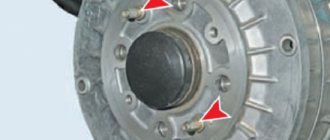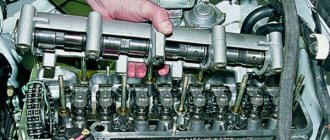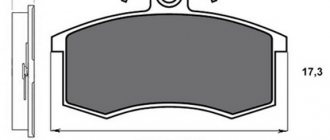Adjustment or how to set timing marks on a VAZ 2106 yourself
Decoding notes
Without pre-basing the pistons and valves, installing the timing chain on the VAZ 2106 according to the marks is impossible. Therefore, the significance of the marks is not at all conditionally decorative. The signs give an understanding of the position of parts inside the motor:
- The mark on the KV pulley, which coincides with the long line on the front cover, means that the pistons of cylinders 1 and 4 have reached TDC.
- The mark on the RV sprocket, combined with the tide on the bed, informs about the closed valves in cylinder 4 - this is where the compression stroke occurs.
For your information. The numbering of the “pots” starts from the radiator side.
When the marks coincide, the ignition distributor slider is turned towards cylinder 4, and the valves of the latter are closed. By analogy with setting the clutch on a “classic”, the unambiguity of the relative position of the crankshaft and camshaft serves as the basis for adjusting the clearances in the valve mechanism and the ignition setting procedure.
How to restore tag matches
When the chain is pulled out, the marks will go away. The main difficulty is to return them to a position of mutual coincidence. This work is combined with dismantling the old chain. However, there is no need to rush to remove it - misalignment of all factory markers is fraught with danger.
The base is the position of the crankshaft at which the pulley mark coincides with the long line on the front cover. In this case, the drilling hole for the camshaft star should be closer to the high tide. This must be achieved first. It is worth remembering that the transmission is made with a 2:1 ratio - two revolutions of the crankshaft correspond to one revolution of the camshaft.
- Remove the camshaft sprocket, remove all other gears and the chain stopper.
- Take out the chain.
- Put the camshaft sprocket back (without the chain), tighten the bolt, tighten it, securing the part by the teeth with a screwdriver.
- Rotate the camshaft until the marks on the sprocket and bed coincide.
- After fixing the sprocket with a screwdriver, unscrew the bolt and remove it.
- Install a new chain, sprockets, tensioner shoe and damper plate.
Unnecessary fears when dismantling the RV sprocket are not appropriate. The shaft design includes a pin. In addition to transmitting torque, it serves as a fixator of a certain position.
How to put on a chain
Installation of a new chain begins with its attachment to a new crankshaft sprocket. Next, the damper, tensioner shoe, and limiter are mounted. The chain is passed through the drive shaft gear and secured along the way. Afterwards it is mounted on the camshaft sprocket, and its position is adjusted according to the cycle:
- Put it on the shaft.
- Look at the relative position of the drill bit and boss.
- Take off.
- Move one tooth in the desired direction.
The final procedure is to tighten the chain, during which the tensioner is twisted all the way with good force. After rotating the HF key, the final check of the coincidence of the signs is carried out.
Nuances in installing a timing chain according to factory marks on a VAZ 2106: pitfalls
It is difficult to achieve perfect alignment of two pairs of marks. The main reason is the use of components with dimensions within the maximum limit. By the way, adjusting the VAZ 2106 carburetor with your own hands also never follows the ideal scenario - additional recommendations from experienced craftsmen are almost always used.
Allowable elevation shifts
One of the unwritten norms allows for a discrepancy between the sprocket drilling and the camshaft bearing housing boss within a half-tooth in one direction or another. To be more specific, the installation of the timing chain of the VAZ 2106 engine according to the marks is considered complete when the camshaft sprocket is aligned exactly, and the mark of the crankshaft pulley goes slightly forward. This guarantees stable traction throughout the entire speed range.
If the camshaft star is aligned with the mark, and the knee pulley does not reach the TDC mark, the engine operates stably only up to a speed of 100 km/h. After crossing the border, there is a loss of traction and increased fuel consumption.
Extremes
A discrepancy of one tooth between the timing marks and the camshaft sprocket is unacceptable. This is usually evidence of critical chain stretch. When it is new, it is worth inspecting the seat under the key on the crankshaft - perhaps it is broken, hence the excessive play.
Engines with significant mileage are often prone to arbitrary changes in the location of the RV star mark during the rotation of the HF. This leads to:
- Slicked teeth in engagement of the gear shaft of the oil pump drive with the drive shaft (“fungus” with “pig”).
- Play in the distributor.
- Ellipse of timing sprockets.
For your information. Using a split star helps achieve perfect mark placement. It is installed to replace the standard camshaft gear.
Briefly about the main thing
The technology for setting timing marks on a VAZ 2106 engine is performed with the chain removed. A sprocket mounted on the camshaft without a chain is fixed with a screwdriver and tightened with a wrench. After rotating the camshaft in the desired direction and combining the drilling with the boss on the bed, the gear is again immobilized with a suitable object and dismantled. Next, the new chain is installed.
Perfect alignment of the marks can only be achieved by using a split gear. However, this is not at all necessary to comply with. It is quite possible that the camshaft marks coincide and the crankshaft pulley moves a little forward.
Design and purpose of the camshaft
With all the variety of elements and associated systems of a car engine, the power plant is a rationally coordinated single mechanism. The engine of the “six” is represented by a four-stroke type “engine”, and the alternation of strokes is strictly regulated. This determines the purpose of the VAZ 2106 camshaft, the price of which is relatively high and amounts to 1000-1200 rubles, depending on the manufacturer.
The classic camshaft of the VAZ 2106 is responsible for the sequence (established order) of the operation of the valve elements to open and close the product for the removal of gas products of combustion of the air-gasoline mixture and the operation of the intake fuel line.
The main working body of the camshaft is the cams, which, through the influence of other elements of the product, including the camshaft chain, “open” the valves at a given frequency. The camshaft chain itself interacts between the gear and the camshaft sprocket of the “six” by means of a chain transmission.
Each valve corresponds to a separate cam, which, when operated by the action of a pusher on the protruding segment, presses on the valve element, which causes it to rise, which is why, depending on the position of the element, either a fuel-air mixture enters the cylinder or exhaust gases are discharged. When the pusher is released from contact with the protruding element, the spring “slams” the valve element with its tensile force.
The VAZ 2106 camshaft support neck is used for mounting the product in a retracted position. The mating parts are hardened using high-frequency current and are lubricated during operation.
Replacing the camshaft in a VAZ 2106 car
Scheduled camshaft replacement is not carried out very often if it is subjected to proper use. The scope of dismantling work is small and does not present much difficulty. Sequence of work:
- We remove the over-valve casing and unscrew the chain tensioner of the gas distribution mechanism drive system.
- We unscrew the camshaft gear; to avoid cases of unauthorized rotation of the shaft, it is necessary to fix the position of the vehicle in the gear position and secure it by installing chocks under the wheels of the car.
- We move the dismantled system to the side in order to continue technological operations.
- We dismantle all the fasteners of the body part (bed) of the camshaft in any order, in contrast to their subsequent installation.
- We dismantle the body part of the product, rocking it somewhat for a more successful descent from the studs.
- To remove the camshaft, unscrew the 2nd nut securing the product to the bed, located in the front part.
- By tapping with the handle of a plumber's hammer, we achieve translational movement of the shaft from the seat.
- We remove the shaft from the housing part.
The technological operation for installing the VAZ 2106 camshaft is carried out according to the opposite scenario. If there is a need to replace the camshaft due to high production, this is carried out together with the rockers. Removing them from their seats is not difficult; you just need to unfasten the spring-type fastener.
Otherwise, when assembling the product, it is necessary to use a torque wrench to tighten the camshaft to correctly determine the tightening torque of the camshaft, i.e. what force needs to be applied for this. As for the repair of the VAZ 2106 camshaft, metal spraying on the cams is rarely used to achieve the required dimensions for the correct operation of the product. Some car enthusiasts install a camshaft from the Niva on a VAZ 2106 to increase power. This, in principle, is an element of car tuning, and gives an increase in power both at the lower and upper speeds of the engine.
The modern sports camshaft on the VAZ 2106 is installed on tuned six engines to achieve different, improved power characteristics. Car enthusiasts should know that engine dynamics are directly related to the performance characteristics of the vehicle’s camshaft. These products, which transmit the moment of movement from the crankshaft of the power plant to the valve group, are produced in one piece with cams.
There is a special adjustable camshaft star (another name for the Vernier pulley), which allows you to set the camshaft “advanced” in such a way that at TDC the lifting point of the intake type valve will be higher than the similar parameter of the exhaust type valve. At the same time, installing the camshaft on the so-called. the moment of “lag” will change the indicator of the intake product. This proportion between the valve lift coefficient at TDC shows the degree of efficiency when operating a camshaft of one type or another.
The theoretical rule can be formulated as follows: the amount of advance of the shaft will shift the power indicator down the rpm range, and the amount of lag will have the opposite effect. Only adjusting the camshaft of the VAZ 2106 will make it possible to increase the power parameters of the vehicle.
Replacing the camshaft on a VAZ 2106 may be required for various reasons, but before moving on to this process you need to have an idea of the purpose of this unit. The camshaft is the main timing link and participates in the combustion process of the combustible mixture.
The camshaft is located at the top of the cylinder head. It is connected to a pulley or toothed sprocket of the crankshaft via a belt or chain drive.
Malfunctions of the VAZ 2107 camshaft, their symptoms and causes
Considering that the timing shaft is subject to constant dynamic and temperature loads, it cannot last forever. It is difficult even for a specialist to determine that this particular unit has failed without detailed diagnostics and troubleshooting. There may be only two signs of its malfunction: a decrease in power and a quiet knocking sound, which manifests itself mainly under load.
The main camshaft faults include:
- wear of the working bodies of the cams;
- wear of the surfaces of the bearing journals;
- deformation of the entire part;
- shaft fracture.
Wear of cams and journals
Wear is a natural occurrence for a constantly rotating part, but in some cases it can be excessive and premature. This leads to:
- insufficient oil pressure in the system, as a result of which lubricant does not flow to loaded areas or is supplied in smaller quantities;
- low-quality motor oil or one that does not meet established requirements;
- defect in the production of the shaft or its “bed”.
If the cams wear out, the engine power is noticeably reduced, since they, being worn out, cannot provide either the appropriate phase width or the required lift of the intake valve.
When the cams wear out, engine power drops
Deformation
Camshaft deformation occurs as a result of severe overheating caused by malfunctions of the lubrication or cooling systems. At the initial stage, this malfunction may manifest itself in the form of a characteristic knocking sound. If you suspect such a breakdown, further operation of the car is not recommended, as it can damage the entire gas distribution mechanism of the engine.
Deformation occurs due to malfunctions in the lubrication and cooling systems
Fracture
A camshaft fracture may be a consequence of its deformation, as well as poor timing. In the event of this malfunction, engine operation stops. In parallel with this problem, others arise: destruction of the shaft “bed”, bending of valves, guides, damage to parts of the piston group.
A shaft fracture may be a consequence of deformationIf the camshaft fails
The camshaft on the VAZ 2106 model is rarely dismantled. Typically during repair or disassembly. Sometimes to replace it.
Signs
First, let's talk a little about the signs that indicate that the camshaft is faulty, its journals or beds are worn out. It is difficult to determine whether the shaft or something else is knocking in the VAZ 2106 engine, but it is possible. The knock of the camshaft is dull and clearly audible. As engine speed increases, the knocking becomes more frequent.
Some drivers determine knocking in this unit using a stethoscope or a stick through the valve cover. But often it is difficult for an inexperienced driver to do this. Therefore, the best way to diagnose the camshaft is to remove it, wash it and inspect it.
If the camshaft is faulty, the following symptoms may occur:
- a dull knock, reminiscent of hammer blows;
- it is impossible to adjust the valve clearances; while the crankshaft is turning, the camshaft is constantly in different positions.
Equipment diagnostics
If, while the vehicle engine is running, the self-diagnosis system finds an error in the operation of the sensor, the indicator lights up, indicating a malfunction of the equipment. In this case, it is necessary to make sure that there are no breaks in the electrical circuits, check the contact between the vehicle engine and the shielding of the cable, make sure that all connectors are correctly connected, and examine the surface of the sensor for mechanical damage.
If diagnostics, either independently or with the involvement of service station specialists, reveal the presence of irreparable breakdowns, the sensor must be replaced.
Replacement Guide
The work of removing the crankshaft on a VAZ 2106 is somewhat labor-intensive, but a driver with little experience can do it. We do not need special equipment or special tools to work.
Set of tools
- set of heads;
- ratchet;
- knob;
- extension;
- a set of keys;
- rags.
Sequencing
- To get to the crankshaft, you first need to remove the air filter and housing.
- Next, disconnect the choke cable.
- Gas damper drive.
- Clean and wash the valve covers thoroughly. Usually dust and dirt accumulate on it, otherwise they may get inside the motor.
- Now you need to unscrew all the nuts and remove the valve cover. Experts recommend replacing the gasket when removing the valve cover. When purchasing, buy a rubber-cork one, as it holds oil much better than rubber.
- By removing the cover, we gain access to the camshaft; in most cases it is very dirty.
- Now you need to loosen the camshaft sprocket fasteners. To prevent the motor from turning over, insert a screwdriver between the sprocket and the chain.
- Important! Be sure to align the mark on the crankshaft and the camshaft sprocket. You must strive to ensure that the mark on the crankshaft pulley is against the long mark, and the mark on the camshaft sprocket is against the protrusion on the camshaft bed.
- After alignment, we proceed to removing the chain tensioner.
- Unscrew the nuts with a wrench.
- Remove the tensioner.
- We remove the star, which is located on the guide pin.
- After unscrewing the bolt securing the sprocket, remove the sprocket. A hammer may be needed here.
- We tie it to a chain.
- Now you need to unscrew the nuts securing the crankshaft and remove it.
- By the way, it will be noted that if a stud with a nut is turned out, then it is screwed back in with a special stud turner.
- Next, we inspect the camshaft and replace it if necessary.
- The shaft is clamped according to the diagram. The tightening order must be observed. The tightening torque is also important. On a VAZ 2106 car, the tightening torque is 18.3 N/m.
- When assembling, be sure to check that the marks are aligned correctly. If they are out of order, they need to be set correctly.
- Finally, adjust the tension of the chain and valves.
If you still have questions and do not understand how the installation is carried out, at what torque the tightening is done or how to set the marks, then after reading, watch the video we offer.
Skoda Superb 1.8T › Logbook › Final repair of the cylinder head (+ restoration of the camshaft beds)
The problem was described in an earlier post. Thanks everyone for the advice! Indeed, it turned out that the oil seals on the Erling intake valves were either fake or simply of poor quality. Carbon deposits formed on the intake valves, which prevented them from closing. And also, I think that this was the reason for my slight oil burn, which, as I initially assumed, was due to VKH. Now to the point. It was decided to replace the valves, unscrew the bushings, since some of the valves were slightly wedged in them, loosen the seats, and grind them in. The reamer was bought in a store at 7mm, if I’m not mistaken, but with cutters it’s more difficult. We found where to buy a set for a VAZ 2110. The angle of one of the cutters there corresponds to the angle of my cylinder head, but the pin is already 1mm smaller in diameter. We had to look for the axers that this pin made for us.
Next comes the processing of the saddles themselves. First, let's talk. Somehow some of the saddles themselves turned out imperfectly, so they found someone who helped and suggested. In general, we coped with the task.
We grind long and hard.
We collect everything and start it up. Works fine. We try to give gas, something happens in the engine, a loud knock appears. Disassemble again... We remove the cover and see that the hydraulic compensator has jumped out, got under the camshaft, and that in turn melted the camshaft bed... The picture is terrible. It is not clear why the rocker jumped out like that, or the pump simply didn’t pump enough oil, and the camshaft itself first scratched the bed. The fact is that the head and valve cover are damaged. It's not cheap. I wanted to have the head restored at Mechanics, but they refused because nothing would work well anyway. I found another one that took my cylinder head to work. The camshaft is slightly damaged, but not critically, there is no runout, so I decided to leave the old one (a new one costs at least 30 thousand). Here is what has deteriorated on the shaft:
I would like to express my gratitude to the employees of MotorIntech LLC for their quality work, in particular to the Inspector Yuri for his respectful attitude towards clients. Within a week they completed all the work to restore the beds, as promised. All this cost me 13 thousand, and a working used cylinder head costs about 50 thousand.
Video “Replacing the shaft”
This video shows how to properly remove and install the camshaft, replace rockers, springs and other shaft components on a VAZ 2106 car. And also at what torque the tightening occurs.
The camshaft on VAZ 2106 cars is removed in exceptional cases. Usually, either during repair and disassembly of the engine, or to replace it. It is not so difficult to remove and for this you will need a tool such as:
- Head for 17 and 13
- Ratchet handle
- Vorotok
- Extension
- Open-end or socket wrench 13
The first step is to completely remove the valve cover from the cylinder head. Then unscrew the timing chain tensioner, which is located on the right side in the front of the engine (in the direction of travel):
After this, we turn off the camshaft gear with a 17 key. To avoid turning, you need to put the car at speed and put stops under the wheels so that it does not roll.
After which we take it to the side, you can slightly pry it with something:
Next, you can begin to unscrew all the nuts securing the housing (case) of the VAZ 2106 camshaft. First, you can slightly loosen them with a wrench, and then quickly unscrew them with a ratchet:
After all the nuts are completely unscrewed, you can grab the shaft cover and pull it up with the necessary force, rocking it a little to the side to make it easier to do all this:
To remove the camshaft from the cover, you need to unscrew two nuts with a 10mm wrench, which are located in the front of the part; in the photo below they are shown with marks in numbers:
Now you can lightly hit the back of the camshaft with at least the handle of a hammer (wooden), and it will move forward:
By carefully pulling it forward, it is finally removed, the result of which is shown in the photo below:
The installation process occurs in reverse order. If the shaft needs to be replaced due to severe wear, then replace the rockers at the same time. They can be removed very simply; you just need to lift each of them up, overcoming the resistance of the spring clamp, and the rocker can be removed freely:
If the shaft will not be changed, and the rockers are still quite suitable for further work, then you need to install them in the same sequence in which they were removed (if you remove them at all):
TIMING BELT ACCESS
The timing of these bolts is shown in the photo fig:
below 6. Upper timing cover bolts
Unscrew then, using the same key, two bolts of the lower timing mechanism cover and remove the cover.
Bolts 7. fig lower timing cover
Using a 17-tooth head, we turn the crankshaft pulley until the marks are set in exactly the same place according to Figure 4. You also need to check that the marks on the flywheel match so that they are located as shown in Figure 3. The crankshaft must be turned clockwise.
And one more important point! It is the crankshaft that needs to rotate the entire timing mechanism. This cannot be done behind the camshaft pulleys...
To prevent the camshaft marks from getting lost during operation, they must be secured together. This is done in different ways. I once saw how a mechanic inserted a socket head between the pulleys with teeth. You can also take a hairpin and two thick plates the size of a hairpin. We put plates on the holes, insert nuts on both sides of this structure between the pulleys so that the plates rest against the teeth of the pulleys and tighten the nuts.
It looks something like this! True, here is an engine from another car:
Tool 8. RIS for fixing camshafts
We have completed the preparatory work and it is time to proceed directly to replacing the Priora timing belt.
To remove the timing belt of the Priora mechanism, you first need to loosen its tension. To do this, unscrew the tension roller nut with a 15mm wrench; the support roller must also be removed. Because when replacing the timing belt, both then change.
roller, remove the timing belt and carefully inspect it
First of all, we pay attention to the presence of cracks, fraying of the edges of the belt, and, of course, the condition of the teeth. There should be 137 of them, they should be round If
form, you have found at least one of these defects or the time has come based on mileage in kilometers, then the Priora timing belt must be replaced with a new one. Next, you need to pay attention to the condition of the pump. gear by holding the pump pulley, you need to tug it, if there is any play in the pulley, then the pump must be replaced.
REPLACING THE PRIORA PUMP
In order to replace the pump, we will have to drain the coolant. Using a 15 wrench, unscrew the gear nuts, remove the camshaft pulleys and the rear timing cover.
It should be borne in mind that the camshaft pulleys cannot be mixed up; the exhaust and intake pulleys are placed exactly in their places...
To remove the back cover, you need to use a 10mm socket socket and unscrew the six bolts securing this cover.
The location of these bolts is shown in the figure below:
FIG 9. Bolts of the rear timing cover of the Priora
This picture also shows the bolts and mountings of the Priora pump. These bolts are unscrewed with a 5mm hexagon. Having unscrewed the bolts, you need to pry the edge of the pump with a flat screwdriver and remove it from its seat. Before installing a new Priora pump, you need to clean the surface to which it is adjacent. It is advisable to degrease it and cover it with a thin layer of sealant. The new pump should also be coated with sealant, the place where the gasket is installed
When installing the pump, pay attention to the control hole; the hole should be at the bottom. three Tighten the bolts securing this unit and you can now install and secure the rear cover of the gas distribution mechanism
INSTALLING THE PRIORA TIMING BELT
- Before installing the Priora timing belt, we put our camshaft toothed pulleys in place, making sure that the marks are strictly on their pulleys. We install our own exhaust and intake camshafts in their required places. Let's forget about this! At the same time, it is necessary to install a sensor phase ring under the intake camshaft pulley.
- After checking the position of the marks on the camshafts, we put the rollers in place on the crankshaft. Tension only, bait on the left. The supporting one located on the right “his”, the parasitic one can be immediately secured until it stops.
- crankshaft c We start by putting a timing belt on its toothed pulley, from bottom to top. Then, holding both sides with your hands, we first place the belt on the pump pulley, then at the same time place the rollers on the reverse side. Next, while holding the belt tension, pull it up and to the sides and put it on the pulleys. In this case, you must carefully monitor the position of the camshaft marks; they must remain strictly in their places.
- It's time to tighten the gear For. using a special wrench, turn the tension roller counterclockwise until the cutout and protrusion coincide, as shown in the photo below. After this, you can fully tighten the tension roller bolt.
If the camshaft fails
The camshaft on the VAZ 2106 model is rarely dismantled. Typically during repair or disassembly. Sometimes to replace it.
Signs
First, let's talk a little about the signs that indicate that the camshaft is faulty, its journals or beds are worn out. It is difficult to determine whether the shaft or something else is knocking in the VAZ 2106 engine, but it is possible. The knock of the camshaft is dull and clearly audible. As engine speed increases, the knocking becomes more frequent.
Some drivers determine knocking in this unit using a stethoscope or a stick through the valve cover. But often it is difficult for an inexperienced driver to do this. Therefore, the best way to diagnose the camshaft is to remove it, wash it and inspect it.
If the camshaft is faulty, the following symptoms may occur:
- a dull knock, reminiscent of hammer blows;
- it is impossible to adjust the valve clearances; while the crankshaft is turning, the camshaft is constantly in different positions.
This video shows how you can eliminate longitudinal runout of a camshaft.
The most reliable method for diagnosing problems with the VAZ 2106 camshaft is to dismantle it from the car and wash it. You can wash it in gasoline or other cleaning liquid. Next, you need to hold the shaft and hit the bed, when you hear the slightest knock, we determine whether the mechanism is worn out. Be sure to make sure that the shaft does not move in bed, because when it hits the limiter it will make a dull knock.
Removed shaft
The camshaft has a great influence on the pressure in the lubrication system. If the gaps between the bed and the camshaft are large, then the pressure will be low, and as a result, unsatisfactory lubrication of other parts.
Causes
The main malfunctions that result in the need to replace the camshaft are its wear, the appearance of various scuffs and grooves on the bearing journals. Likewise, replacing the camshaft is necessary if it is found to be deformed or cracked. When such malfunctions occur, the power unit loses power and also begins to function intermittently. Problems with the camshaft are identified by a knocking sound in the cylinder head.
The camshaft on the “six” is rarely removed. In addition to the above reasons for replacing and reconfiguring the power unit. After this, you can notice a significant increase in power, like in sports cars.
What affects the serviceability and operation of the DPRV
The main factors that affect the operation of the sensor are temperature changes, shaking and metal dust. Therefore, it is necessary to replace the sensor every 100 thousand kilometers. This will avoid unexpected breakdown. When the engine is turned on, the temperature in the sensor area corresponds to the air temperature. As the motor heats up, the temperature of the sensor also increases. If the power supply or ignition systems are not adjusted, the engine runs intermittently, and the sensor is affected by stronger vibrations than designed. The engine has a lot of rubbing metal parts, the movement of which leads to the appearance of dust. If the lubrication system is not working properly, or the engine mounts are faulty, then more metal dust appears than usual. Some of it settles on the magnetic surface of the sensor, negatively affecting its operation.
Replacement Guide
The work of removing the crankshaft on a VAZ 2106 is somewhat labor-intensive, but a driver with little experience can do it. We do not need special equipment or special tools to work.
Set of tools
- set of heads;
- ratchet;
- knob;
- extension;
- a set of keys;
- rags.
Wrenches for tightening and loosening bolts
Sequencing
- To get to the crankshaft, you first need to remove the air filter and housing.
- Next, disconnect the choke cable.
- Gas damper drive.
- Clean and wash the valve covers thoroughly. Usually dust and dirt accumulate on it, otherwise they may get inside the motor.
- Now you need to unscrew all the nuts and remove the valve cover. Experts recommend replacing the gasket when removing the valve cover. When purchasing, buy a rubber-cork one, as it holds oil much better than rubber.
- By removing the cover, we gain access to the camshaft; in most cases it is very dirty.
- Now you need to loosen the camshaft sprocket fasteners. To prevent the motor from turning over, insert a screwdriver between the sprocket and the chain.
- Important! Be sure to align the mark on the crankshaft and the camshaft sprocket. You must strive to ensure that the mark on the crankshaft pulley is against the long mark, and the mark on the camshaft sprocket is against the protrusion on the camshaft bed.
- After alignment, we proceed to removing the chain tensioner.
- Unscrew the nuts with a wrench.
- Remove the tensioner.
- We remove the star, which is located on the guide pin.
- After unscrewing the bolt securing the sprocket, remove the sprocket. A hammer may be needed here.
- We tie it to a chain.
- Now you need to unscrew the nuts securing the crankshaft and remove it.
- By the way, it will be noted that if a stud with a nut is turned out, then it is screwed back in with a special stud turner.
- Next, we inspect the camshaft and replace it if necessary.
- The shaft is clamped according to the diagram. The tightening order must be observed. The tightening torque is also important. On a VAZ 2106 car, the tightening torque is 18.3 N/m.
- When assembling, be sure to check that the marks are aligned correctly. If they are out of order, they need to be set correctly.
- Finally, adjust the tension of the chain and valves.
If you still have questions and do not understand how the installation is carried out, at what torque the tightening is done or how to set the marks, then after reading, watch the video we offer.











